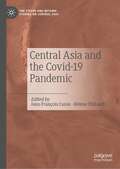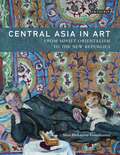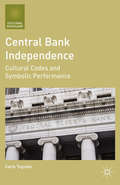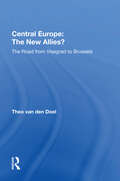- Table View
- List View
Central Asia and the Covid-19 Pandemic (The Steppe and Beyond: Studies on Central Asia)
by Jean-François Caron Hélène ThibaultThis book aims at shedding light on the reasons why the death rates during the pandemic were so high in Central Asia. More specifically, this book proposes analysis on why individuals did not follow the sanitary rules imposed by their respective government and on the role played by misinformation. Secondly, it also examines the impact of Sinophobia in Central Asia and the future challenges this feeling may pose on the authorities in the near future. Lastly, this book also proposes analysis of how the pandemic has contributed to show the inherent vulnerabilities of Kazakhstan and Kyrgyzstan by focusing on their immediate and future political consequences.
Central Asia and the Rise of Normative Powers: Contextualizing the Security Governance of the European Union, China, and India
by Emilian KavalskiThis book offers a unique analytical investigation of the international politics of the EU, China, and India in the context of their security strategies in Central Asia. It shows how the interaction between these three actors is likely to change the frameworks and practices of international relations. This is studied through their interactions with central Asia, using the framework of normative powers and the concept of regional security governance. Briefly, a normative power shapes a target state's attitudes and perceptions as it internalizes and adopts the perspectives of the normative power as the norm. The work comparatively studies the dynamics that have allowed Beijing, Brussels, and New Delhi to articulate security mechanisms in Central Asia, and become rising normative powers. This innovative study does not aim to catalog foreign policies, but to uncover the dominant perceptions, cognitive structures and practices that guide these actors' regional agency, as exemplified through the context of Central Asia. It will be an essential resource for anyone studying international relations, international relations theory, and foreign policy analysis.
Central Asia and the Rise of Normative Powers: Contextualizing the Security Governance of the European Union, China, and India
by Emilian KavalskiThis book offers a unique analytical investigation of the international politics of the EU, China, and India in the context of their security strategies in Central Asia. It shows how the interaction between these three actors is likely to change the frameworks and practices of international relations. This is studied through their interactions with central Asia, using the framework of normative powers and the concept of regional security governance. Briefly, a normative power shapes a target state's attitudes and perceptions as it internalizes and adopts the perspectives of the normative power as the norm. The work comparatively studies the dynamics that have allowed Beijing, Brussels, and New Delhi to articulate security mechanisms in Central Asia, and become rising normative powers. This innovative study does not aim to catalog foreign policies, but to uncover the dominant perceptions, cognitive structures and practices that guide these actors' regional agency, as exemplified through the context of Central Asia. It will be an essential resource for anyone studying international relations, international relations theory, and foreign policy analysis.
Central Asia in a Multipolar World: Internal Change, External Actors, Regional Cooperation (Contributions to Political Science)
by Jakob Lempp Sebastian MayerThis handbook-style edited volume discusses historical, but predominantly current political, economic, and societal trends in Central Asia comprising Kazakhstan, Uzbekistan, Kyrgyzstan, Tajikistan, and Turkmenistan. The five countries exhibit many cultural and historical commonalities and face similar internal and external challenges. Despite different transformation paths and frequent intra-regional tensions, a common regional identity has emerged in the countries since gaining their independence in 1991. Besides covering their political systems, a variety of topics such as human rights, media, terrorism, and civil society are addressed. As well, bilateral relations with seven external actors are examined. Lastly, the authors explore the opportunities and limitations of institutionalized regional cooperation in various fields of action.
Central Asia in Art: From Soviet Orientalism to the New Republics
by Aliya Abykayeva-TiesenhausenIn the midst of the space race and nuclear age, Soviet Realist artists were producing figurative oil paintings. Why? How was art produced to control and co-opt the peripheries of the Soviet Union, particularly Central Asia? Presenting the 'untold story' of Soviet Orientalism, Aliya Abykayeva-Tiesenhausen re-evaluates the imperial project of the Soviet state, placing the Orientalist undercurrent found within art and propaganda production in the USSR alongside the creation of new art forms in Kazakhstan, Kyrgyzstan and Uzbekistan. From the turmoil of the 1930s through to the post-Stalinist era, the author draws on meticulous new research and rich illustrations to examine the political and social structures in the Soviet Union - and particularly Soviet Central Asia - to establish vital connections between Socialist Realist visual art, the creation of Soviet identity and later nationalist sentiments.
Central Asia In Historical Perspective
by Beatrice ManzSince the demise of Soviet power, the newly independent republics are redefining their identities and their relations with the world at large. In Central Asia, which lies at the crossroads of several cultures, the emerging trends are complex and ambiguous.In this volume, leading experts explore factors that have driven the regions historical development and that continue to define it today: overlapping Islamic, Russian, and steppe cultures and their impact on attempts to delimit national borders and to create independent states; the legacy of Soviet and earlier imperial rule in economic and social relations; and the competition between Uzbek, Tajik, and other group identities.The authors make few predictions, but their original and thought-provoking analyses offer readers new insight into those aspects of Central Asias past that may shape its future. Since the demise of Soviet power, the newly independent republics are redefining their identities and their relations with the world at large. In Central Asia, which lies at the crossroads of several cultures, the emerging trends are complex and ambiguous.In this volume, leading experts explore factors that have driven the regions historical development and that continue to define it today: overlapping Islamic, Russian, and steppe cultures and their impact on attempts to delimit national borders and to create independent states; the legacy of Soviet and earlier imperial rule in economic and social relations; and the competition between Uzbek, Tajik, and other group identities. The authors make few predictions, but their original and thought-provoking analyses offer readers new insight into those aspects of Central Asias past that may shape its future.
Central Asia In Historical Perspective
by Beatrice ManzSince the demise of Soviet power, the newly independent republics are redefining their identities and their relations with the world at large. In Central Asia, which lies at the crossroads of several cultures, the emerging trends are complex and ambiguous. In this volume leading experts explore factors that have driven the region's historical development and that continue to define it today: Overlapping Islamic, Russian, and steppe cultures and their impact on attempts to delimit national borders and to create independent states; the legacy of Soviet and earlier imperial rule in economic and social relations', and the competition between Uzbek, Tajik, and other group identities. The authors make few predictions, but their original and thought-provoking analyses offer readers new insight into those aspects of Central Asia's past that may shape its future.
Central Asia in Transition: Dilemmas of Political and Economic Development
by Boris Z. RumerThe economic, political and geopolitical future of Central Asia has been subject to speculation since the region emerged from under the Soviet banner. With contributions from Central Asian, Russian, US and Japanese experts, this book gives an analysis of the issues and choices facing the region.
Central Asia in Transition: Dilemmas of Political and Economic Development
by Boris Z. RumerThe economic, political and geopolitical future of Central Asia has been subject to speculation since the region emerged from under the Soviet banner. With contributions from Central Asian, Russian, US and Japanese experts, this book gives an analysis of the issues and choices facing the region.
The Central Asian Economies Since Independence
by Richard PomfretThe 9/11 attacks, the U.S. invasion of Afghanistan, and the oil boom of recent years have greatly increased the strategic importance of resource-rich Central Asia, making an understanding of its economic--and therefore political--prospects more important than ever. In The Central Asian Economies Since Independence, Richard Pomfret provides a concise and up-to-date analysis of the huge changes undergone by the economies of Kazakhstan, the Kyrgyz Republic, Tajikistan, Turkmenistan, and Uzbekistan since the collapse of the Soviet Union in 1991. The book assesses the economic prospects of each country, and the likelihood that economic conditions will spur major political changes. With independent chapters on each country, and chapters analyzing their comparative economic performance, the book highlights similarities and differences. Facing common problems caused by the breakdown of Soviet economic relations and the hyperinflation of the early 1990s, these countries have taken widely divergent paths in the transition from Soviet central planning to more market-based economies. The book ends in 2005 with the bloodless Kyrgyz revolution and the violence in Uzbekistan, which signaled the end of the region's political continuity. Throughout the book, Pomfret emphasizes the economic forces that foster political instability--from Kazakhstan's resource boom and Turkmenistan's lack of reform to Tajikistan's abject poverty.
The Central Asian Economies Since Independence
by Richard PomfretThe 9/11 attacks, the U.S. invasion of Afghanistan, and the oil boom of recent years have greatly increased the strategic importance of resource-rich Central Asia, making an understanding of its economic--and therefore political--prospects more important than ever. In The Central Asian Economies Since Independence, Richard Pomfret provides a concise and up-to-date analysis of the huge changes undergone by the economies of Kazakhstan, the Kyrgyz Republic, Tajikistan, Turkmenistan, and Uzbekistan since the collapse of the Soviet Union in 1991. The book assesses the economic prospects of each country, and the likelihood that economic conditions will spur major political changes. With independent chapters on each country, and chapters analyzing their comparative economic performance, the book highlights similarities and differences. Facing common problems caused by the breakdown of Soviet economic relations and the hyperinflation of the early 1990s, these countries have taken widely divergent paths in the transition from Soviet central planning to more market-based economies. The book ends in 2005 with the bloodless Kyrgyz revolution and the violence in Uzbekistan, which signaled the end of the region's political continuity. Throughout the book, Pomfret emphasizes the economic forces that foster political instability--from Kazakhstan's resource boom and Turkmenistan's lack of reform to Tajikistan's abject poverty.
The Central Asian States: Discovering Independence (PDF)
by Gregory W GleasonExploring the forces of change in the new Central Asian states, Gregory Gleason analyzes their culture, their economic evolution, and their political institutions. Tracing the incorporation of Central Asia into the Soviet system, the regions path of development under socialism, and the vicissitudes of the economic and political collapse of socialism, Gleason considers the trajectories of the new states as they chart their independent futures.
The Central Asian States: Discovering Independence (Westview Series On The Post-soviet Republics)
by Gregory W GleasonThis book traces the incorporation of Central Asia into the Soviet system, the region's path of development under socialism, and the vicissitudes of the economic and political collapse of socialism, before considering the trajectories of the new states as they chart their independent futures.
Central Bank Capitalism: Monetary Policy in Times of Crisis (Currencies: New Thinking for Financial Times)
by Joscha WullweberToday's global financial system bears little resemblance to what it was at the end of the twentieth century. Shadow banking—financial activity taking place outside existing regulatory frameworks—has grown so important that it now serves as the backbone of the entire system. The shadow banking system, however, is highly unstable and the main reason why the financial system has remained in crisis mode since the 2008 financial crisis. To maintain stability, central banks like the Fed and the European Central Bank have come to use radical new monetary policy instruments which were inconceivable until very recently. Without intervention on the part of central banks, existing financial systems would completely collapse. As Joscha Wullweber shows, there has been a radical change in the state-market nexus. With governments refraining from strong and comprehensive fiscal and financial regulatory policies, central banks have become the main stabilizing force and the nodal point of financial circulation. These overburdened institutions are called on to make near-daily interventions to avert crisis. Wullweber calls this historic phase central bank capitalism. His book offers a lucid account of our current state of permanent crisis with its new dilemmas and paradoxes that pose enormous challenges to financial and economic stability.
Central Bank Capitalism: Monetary Policy in Times of Crisis (Currencies: New Thinking for Financial Times)
by Joscha WullweberToday's global financial system bears little resemblance to what it was at the end of the twentieth century. Shadow banking—financial activity taking place outside existing regulatory frameworks—has grown so important that it now serves as the backbone of the entire system. The shadow banking system, however, is highly unstable and the main reason why the financial system has remained in crisis mode since the 2008 financial crisis. To maintain stability, central banks like the Fed and the European Central Bank have come to use radical new monetary policy instruments which were inconceivable until very recently. Without intervention on the part of central banks, existing financial systems would completely collapse. As Joscha Wullweber shows, there has been a radical change in the state-market nexus. With governments refraining from strong and comprehensive fiscal and financial regulatory policies, central banks have become the main stabilizing force and the nodal point of financial circulation. These overburdened institutions are called on to make near-daily interventions to avert crisis. Wullweber calls this historic phase central bank capitalism. His book offers a lucid account of our current state of permanent crisis with its new dilemmas and paradoxes that pose enormous challenges to financial and economic stability.
Central Bank Independence: Cultural Codes and Symbolic Performance (Cultural Sociology)
by C. TognatoBy engaging in an ethnography of the social text of German, European and USA monetary affairs, this book introduces a new analytical framework that will enable practitioners and academics, particularly within sociology, economics, political economy, and political science, to gain a clear understanding of the role of culture in central banking.
Central Bank Policy Mix: Handbook of Central Banking Studies
by Perry Warjiyo Solikin M. JuhroThis is an open access book.This book is an integration of keynote speeches, lectures, and related teaching materials during the five years of the "Central Bank Policy Mix: Issues, Challenges and Policy Responses" flagship program of the BI Institute, the learning and research centre of Bank Indonesia. The book examines the interactions among central bank policies including monetary policy, exchange rate policy, macroprudential policy, and capital flow management and also elaborates on modeling issues and quantitative analysis of the interaction between macroeconomic variables and policy instruments.
Central Bank Reserves and Sovereign Wealth Management
by A. Berkelaar J. Coche K. NyholmThis is an edited collection of essential readings on Reserves Management and Sovereign Wealth Management, from the recent SAA conference organized by the Bank for International Settlements, the European Central Bank and the World Bank Treasury. It offers an exchange of views on technical and implemental issues of financial models.
Central Banking and Financial Stability in East Asia (Financial and Monetary Policy Studies #40)
by Frank Rövekamp Moritz Bälz Hanns Günther HilpertThis book explores financial stability issues in the context of East Asia. In the East Asian region financial stability has been a major concern ever since the Asian crisis of 1997/98, which still looms large in the collective memory of the affected countries. The global crisis, which had its starting point in 2007, only served to exacerbate this concern. Safeguarding financial stability is therefore a major goal of any country in the region. Diverging cultural, political and economic backgrounds may however pose different stability challenges and necessary cooperation may be complicated by this diversity. Against this backdrop the contributions of this book by leading academics from the fields of economics and law as well as by practitioners from central banks shed light on various financial stability issues. The volume explores the legal environment of central banks as lenders of last resort and analyzes challenges to financial stability such as shadow banking and the choice of exchange rate regimes. Case studies from China, Japan and Indonesia are contrasted with experiences from Europe.
Central Banking and Financialization: A Romanian Account of how Eastern Europe became Subprime (Studies in Economic Transition)
by D. GaborThis book explores the causes and effects of the rise of neoliberalism in Eastern Europe in the aftermath of the collapse of the Soviet Union. It provides a political economy analysis of the role of central banks, and identifies them as a key actor in the production and dissemination of the neoliberal economic policies.
Central Banks and Gold: How Tokyo, London, and New York Shaped the Modern World (Cornell Studies in Money)
by Simon James Bytheway Mark MetzlerIn recent decades, Tokyo, London, and New York have been the sites of credit bubbles of historically unprecedented magnitude. Central bankers have enjoyed almost unparalleled power and autonomy. They have cooperated to construct and preserve towering structures of debt, reshaping relations of power and ownership around the world. In Central Banks and Gold, Simon James Bytheway and Mark Metzler explore how this financialized form of globalism first took shape a century ago, when Tokyo first joined London and New York as a major financial center.As revealed here for the first time, close cooperation between central banks began along an unexpected axis, between London and Tokyo, around the year 1900, with the Bank of England’s secret use of large Bank of Japan funds to intervene in the London markets. Central-bank cooperation became multilateral during World War I—the moment when Japan first emerged as a creditor country. In 1919 and 1920, as Japan, Great Britain, and the United States adopted deflation policies, the results of cooperation were realized in the world’s first globally coordinated program of monetary policy. It was also in 1920 that Wall Street bankers moved to establish closer ties with Tokyo. Bytheway and Metzler tell the story of how the first age of central-bank power and pride ended in the disaster of the Great Depression, when a rush for gold brought the system crashing down. In all of this, we see also the quiet but surprisingly central place of Japan. We see it again today, in the way that Japan has unwillingly led the world into a new age of post-bubble economics.
Central Debates in British Politics
by John Benyon David Denver Justin FisherCentral Debates in British Politics focuses on British politics in a changing social, economic and institutional context. The book explores issues and debates using a variety of approaches and techniques. It is written and edited by a team of leading experts who analyse key issues in a highly structured and thematic manner.
Central Debates in British Politics
by John Benyon David Denver Justin FisherCentral Debates in British Politics focuses on British politics in a changing social, economic and institutional context. The book explores issues and debates using a variety of approaches and techniques. It is written and edited by a team of leading experts who analyse key issues in a highly structured and thematic manner.
Central Documents and Politburo Politics in China (Michigan Monographs In Chinese Studies #33)
by Kenneth Lieberthal James Tong Sai-cheung YeungVirtually every analysis of Chinese politics views the Politburo as the nerve center of the system, but questions abound as to how this center governs itself and how it interacts with the system around it. Specifically, how much consultation occurs during the drafting of major Politburo documents, and who is brought into this process? How is information channeled up to this body, and what are the rules that govern the access of the Politburo members themselves to data generated by the bureaucracies? How are the political strategies of individual leaders and political factions attuned to this system of information channeling? What types of decisions are reached by the Politburo? To whom are they communicated? How rigidly must they be followed? How institutionalized is this entire decision making system, and has it become more—or less—institutionalized over the years? How has the factional legacy of the Cultural Revolution affected its mode of operations? Indeed, in the wake of the Cultural Revolution, how much in control of the system has the Politburo itself been? Central Documents in Politburo Politics in China seeks to better understand these questions by analyzing a particular stream of largely bureaucratic communications in the Chinese system: the so-called “Central Documents” (CDs). This is a series of documents through which the top Party leadership directly communicates with the rest of the political system. [1]
Central Europe: The Road From Visegrad To Brussels
by Theo Van Den DoelOriginally published in 1994. In 1989 Poland, Hungary and Czechoslovakia began to cooperate as a regional grouping in the Warsaw Treaty Organisation(WTO). With the primary objective to cooperate with western organisations they have also worked to dismantle the WTO and the CMEA. Since 1991, they have been regarded as the Visegard Group which now includes the Slovak Republic as well as the newly named Czech Republic. The subtitle reflects the author's belief that in comparison with other WTO states, this Group of four nations are on a fast track in their objective of being a member of NATO.


















